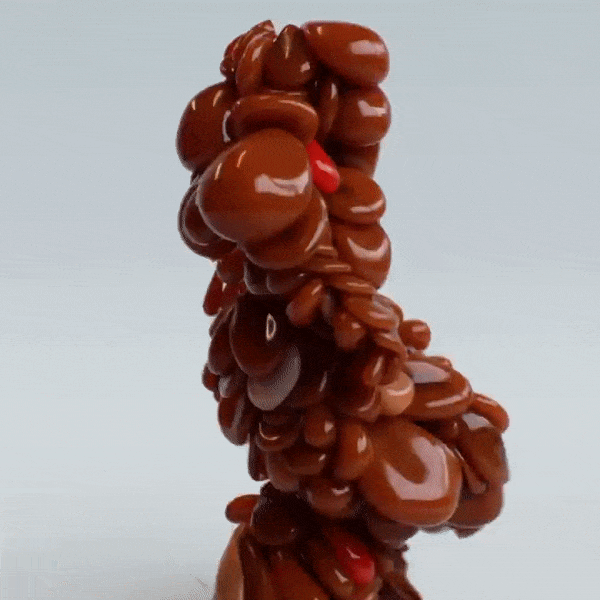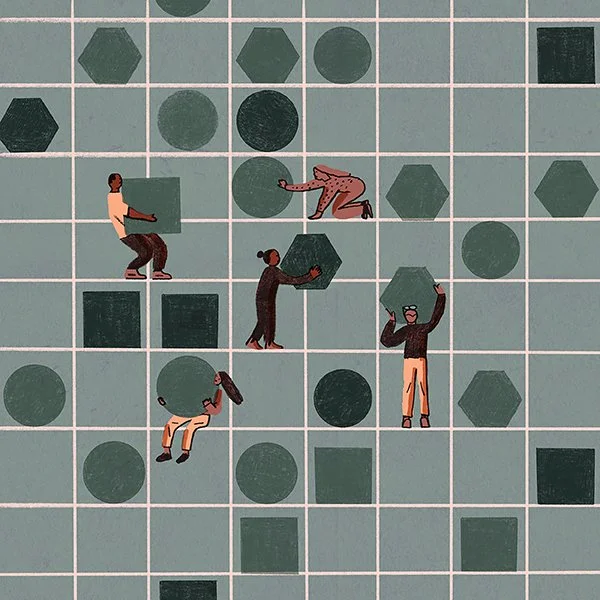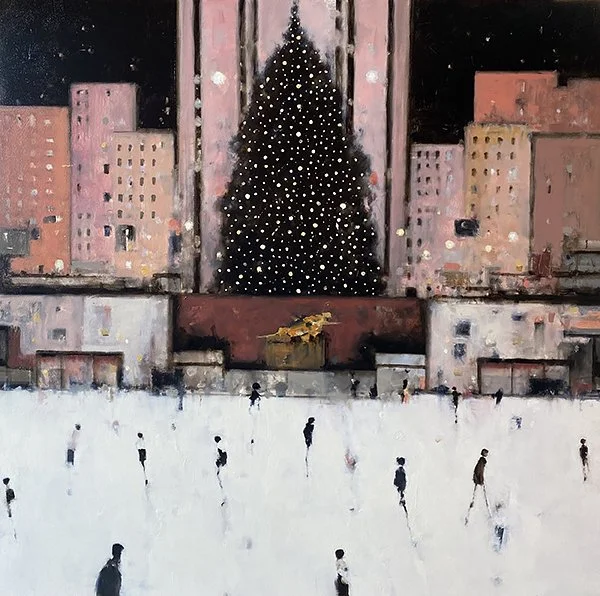In Conversation: Esteban Diacono
Esteban Diacono’s fascination with math and patterns has led him to first-class collaborations in fashion, beauty, art, music, and design. In 2008, he created a self-initiated piece inspired by Ólafur Arnalds’ tune Ljósið, which not only became viral, but also got noticed by Ólafur himself and ended up being used as the official video for the track. Diacono’s compelling and mesmerizing 3D animations have been used in campaigns and ads for Apple, Gucci, Iris van Herpen, Nike, Coachella, Fender, and Mtv. Nonetheless, Esteban considers himself just a creator, refusing to overpraise his impact by deliberately avoiding the term artist. Whether catering to big clients or expressing himself in experimental projects, his devotion to the process (not to mention a spot-on execution) is self-evident and doesn’t need to be validated, defined, or labeled.
KELLY KORZUN: You grew up and spent most of your early years in Córdoba, Argentina. Can you describe a typical day of your life when you were a kid? When you reminisce, what’s the fondest recollection of memories or emotions from your childhood?
ESTEBAN DIACONO: Villa Carlos Paz, the city I grew up in, was a very small town back then, with probably around 15000 people living there, so there wasn't much to do besides being outside all day. Growing up, I mostly enjoyed two things: cycling and messing around with computers. A typical day would be going to school in the morning, a quick ride home for lunch, and immediately after the last bit, grabbing my bicycle and heading out again. In those days, I would spend most of the day outside, pedaling around the city, or reading a book by the lake. Later in the day, I would return home, sit in front of one of my early computers (a Spectrum, or a Commodore 64, depending on the year) and play games or write a few lines of basic code, following a tutorial from a magazine. A little later in life, I discovered the wonders of VHS technology and started watching basically every movie available to rent, especially sci-fi and horror. It was a pretty good childhood.
KK: Initially, you started out as a graphic designer, but ended up dropping out of the university for personal reasons and teaching yourself everything you know today. Looking back, what was the most difficult experience during that time, and what made you realize that you were on the right track?
ED: The most difficult thing at the time was to stay motivated to continue pursuing my passion. The only access to information was through books or foreign magazines, which were expensive and very unlikely to be found at every shop. Ultimately, I learned some design principles and theory just by squeezing every bit of reading material I could get my hands on, and a little later in life, consulting with friends who were already doing some design work and asking a ton of questions. Eventually, I convinced my mom to lend me some money to buy a computer (which in her mind was a crazy idea), and after that I would spend 75% of my day messing around with 3D Studio and Corel Draw. After working for a small video production company and being the only person in town doing that type of work, other companies started to call and ask for animations. Eventually, I started working my way up to more complex projects and bigger clients, which led me to Buenos Aires around 2004 when I got a job at the biggest motion design studio in the city. The new job was definitely challenging, but the most difficult part was suddenly being surrounded by people with a formal education and a strong sense of design, and for the first few months I experienced a very high degree of impostor syndrome and was basically waiting to be fired everyday, but in the end it was the complete opposite. Most of my coworkers had a ton of design knowledge, but they lacked the experience and technical expertise I had amassed in all those years of self-education. I found that you don't have to be good at everything, and that you can complement other people's skills and talents with your own. It took me years to realize that it wasn't just luck, a certain circumstance or a random coincidence that put me on this path, and that I was good at pushing pixels around. Deep inside, I've always felt that this is what I was supposed to do, and through hard work and lots of effort, I've been able to prove to myself again and again that this initial instinct was right.
KK: You’ve collaborated with Sagmeister & Walsh on a number of projects. How did that relationship come about, and what did you take away from that experience?
ED: Around 2013, I was invited to give a talk at the OFFF Festival in Barcelona. Being a shy person, I’m not particularly good at networking, but a part of me clearly understood that sharing a stage with a bunch of very talented people was a great opportunity to grow, so I decided to get in touch with people whose work I found particularly interesting, including Jessica Walsh, who had just announced her partnership with Stefan Sagmeister, one of my all-time heroes. She was kind enough to reply to my message, did some digging, and apparently liked my work. At that time, S&W were working on an exhibition called Six Things, scheduled to take place at the Jewish Museum in NYC. Stefan had an idea for a piece and they wanted to see if it could be made digitally, but I decided to take full advantage of the opportunity and suggested doing it from their studio, so I ended up working on-site for about three months and getting to know them. Being in New York and casually grabbing lunch with this amazingly talented group of people felt surreal. Besides Stefan, everyone else was significantly younger than me, so I kind of felt like Robert De Niro in The Intern, working side by side with twenty-somethings. Nevertheless, I did enjoy the experience of being NYC’s oldest intern. After the project wrapped up, we continued collaborating on other stuff, including Stefan's film and a bunch of client work. I still have a lovely relationship with both of them, and we get together for lunch or drinks when I’m in the city.
KK: Can you walk us through your creative process? Besides accurately capturing movement with motion capture, what other things do you pay attention to when it comes to character creation?
ED: The intention is always to surprise the viewer. I like the idea of using human characters as some sort of canvas because I like taking something that feels completely natural to us (like the human form, a walk cycle) and adding something unexpected. I’m not that interested in portraying the exact image I have in mind – it’s more about finding a room for experimentation and playing with ideas, while letting the computer do its part. I really like the idea of randomness or happy accidents when it comes to digital art. One example of this is WLKRS (Walkers), a series I’ve been working on in my spare time, which involves taking a looping walk cycle of a human body, defining certain parameters, generating the conditions for the character to transform and mutate randomly, and seeing what comes out the other end.
KK: Apart from being a full-time creator, you’re contributing to pro-bono initiatives by, for example, creating visualizations to help deaf kids enhance their appreciation for music through visual stimulations. As a motion designer with over 20 years of hands-on experience and no formal education, have you ever considered creating an online course or education platform to pass on that knowledge?
ED: I’ve been offered the opportunity to teach an online course quite a few times, but always declined for different reasons, be it a possible language barrier, or a lack of structure in my mental process. Besides, there are so many courses and tutorials out there on how to create a funky motion capture animation, that I’m not sure if I could add anything new to it. What sets my work apart is the inclusion of randomization, not only in the product itself, but also in the process – sometimes my initial ideas end up being transformed many times as new iterations uncover interesting possibilities. I’m not sure if that kind of curiosity can be taught, it has to be inspired.
KK: When elaborating on your work, you come across as an extremely self-critical person with a very strong work ethic. It looks like discipline means as much to you as it does to Mike Tyson, who praised it, or any other professional athlete. Where do you think this mindset comes from, and how do you normally decompress to avoid burning the candle at both ends?
ED: If I could write down a list of things that could help people make a successful career, discipline would be at the top of the list. I’m not sure if I can pinpoint where it comes from, but I’ve always been like this. Maybe it has to do with the fact that I’m Virgo, or that I know myself so well that I’m very aware of how to make the most of my process. Over the past couple years, I’ve been going to the studio everyday early at 8am (including weekends and holidays) because I’m extremely conscious that I’m most productive in the morning and I want to take full advantage of that time, but once I’m done, I'm REALLY done. To avoid potential distractions and unnecessary hours in front of the computer, I typically head back home around 2pm and have the rest of the day to decompress, maybe exercising, going for a bicycle ride, or lately, trying some of those wonderful PS5 games.
KK: There are many examples when the most expressive and outrageous work is produced by the artists with very introversive personalities. Alexander McQueen, Nick Knight, Marylin Manson, just to name a few – they all had a thing for surrealism and grotesque. Do you see the creative process as some sort of therapy that helps you go places you wouldn’t normally go?
ED: I’ve never been a people’s person. Being around other people would always make me feel very shy and often uncomfortable. In that sense, my work represents a part of me that is more playful and humorous, which normally doesn’t get too much exposure. If you see me walking down the street, it is very unlikely that you’ll think to yourself that I might have some wacky ideas since I don’t really wear the big creator hat or embrace the illuminated life of the artist. Speaking through images and putting my ideas out there has really helped me to realize that no one cares about the things that paralyze and scare you, whether creatively and emotionally.
KK: When Rick Rubin checked with Trent Reznor if he’d be fine with Johnny Cash covering Hurt, Reznor was totally on board with it, but when he got a CD in the post and listened to it, it felt weird: “It was this other person inhabiting my most personal song. Hearing it was like someone kissing your girlfriend. It felt invasive”. To what degree do you get attached to your work, and how do you feel about NFT and all the hype surrounding it these days?
ED: Sure, I can be protective of some of the things I like to a certain extent, but I think there’s no point in trying to exercise that kind of attachment these days when everything pulls in the opposite direction. One of the core ideas of the initial wave of NFT mania was the idea of ownership, but it’s the idea of authorship that is constantly under fire and the one that still needs a better solution. At least once a day I read on Twitter that someone’s art was stolen and is being sold on an NFT marketplace. The people who buy these appropriated images can say “look at the blockchain, I’m the owner of this”, but how can the creators prove their authorship? Posting source files? A process video? A few people would care if there’s money to be made in the middle. At some point, we have to assume that once we put something out there, it is beyond our control. Even if you’re armed with proper trademarks and a decent lawyer, someone somewhere is going to print your stuff on a t-shirt to sell it, and there’s nothing you can do about it. To circle back, I might feel attached to the ideas, the process and the experience of creating, but once it’s out there, I have to exercise some degree of detachment for the sake of my own mental health.
KK: To a certain extent, our perception of the human body is associated with religion and how it was historically portrayed in our society: sacred, created in the image of God, something to be cared for and used for good purposes. The way you play with the human body and its deformations creates a certain distortion of the senses and messes us with the way our brain interprets sensory stimulation, which is one of the reasons your work looks so captivating. Besides experimenting with a human form and motion, are there other phenomenons or concepts you’d like to explore in your work?
ED: Although I'm not that interested in the whole NFT space anymore, it has opened many opportunities for collaboration with other creators, and that is really exciting. I’m planning on more collaborations this year since I really like the idea of playing in someone else's sandbox. On a more personal note, I think there are very interesting opportunities in the realm of digital fashion. I doubt that metaversal digital wearables will be a thing anytime soon as we're a long way from mass adoption, but I do think that we'll see more digital films and experimental mixtures of traditional fashion spiced with digital interventions. At the moment, we continue collaborating with Iris Van Herpen on a series of digital projects, which is super interesting to me. Digital art got a ton of attention over the past few years, from the boom of digital creations on Instagram to the whole world talking about NFTs, and many people from the fashion industry are interested in using digital in more interesting ways than just advertising. There’s also a huge turn from the motion design industry into more experimental stuff that I'm really enjoying and following with interest. As per the future, I don't see myself retiring or slowing down anytime soon, and I think that collaborations and exploring new fields and technologies (holograms are making a really interesting comeback) will help me keep the flame burning. We're extremely lucky to be in a field that is constantly evolving and reinventing itself, and going with that flow is a challenge, but also a pleasure.




